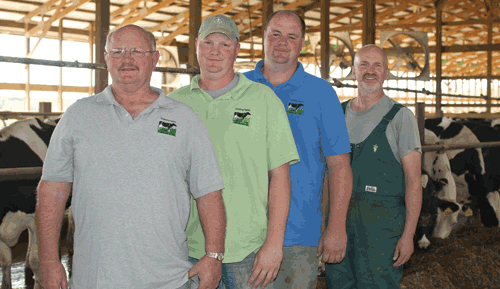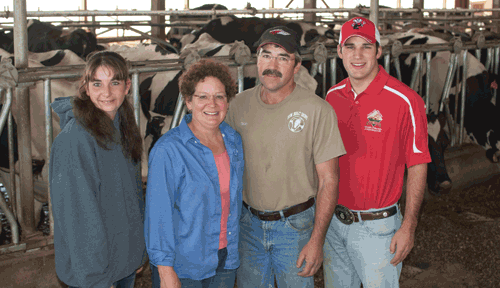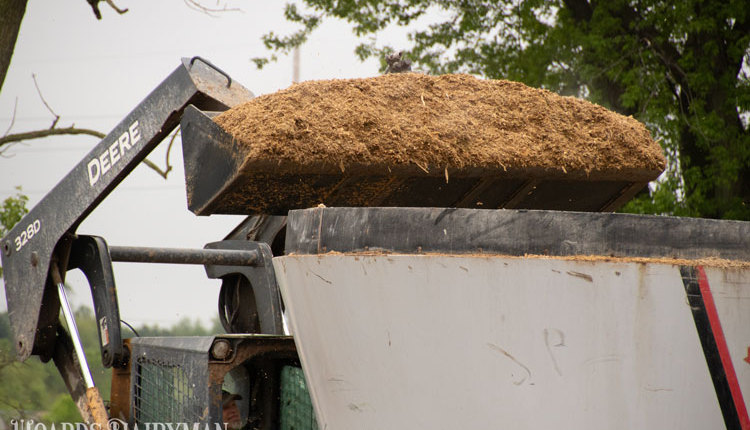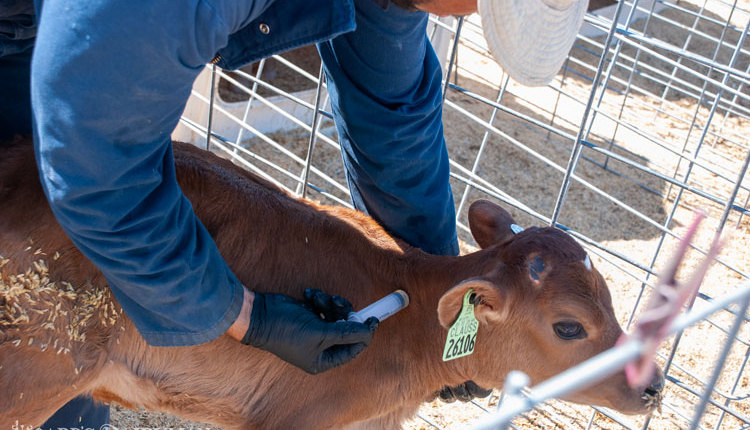Carefully following protocols; keen heat detection; comfortable and well-fed cows; and teamwork are just some of the attributes that helped these five dairies sort to the top of judges' ballots in this year's Dairy Cattle Reproduction Council's (DCRC) Reproduction Awards program. In a very competitive fourth year, the program received 53 nominations from dairies across 17 states, Canada and Mexico. Here, you will find details of how these special herds approach reproduction.
Prebreeding - When do you begin breeding?
Collins Dairy: Our farm's voluntary waiting period (VWP) is 75 days. All cows are set up to be bred between 72 and 79 days in milk (DIM), and all cows are checked to see if they are synchronized by our veterinarian at the prebreeding prostaglandin injection. Those individuals that are cystic or not cycling properly are treated and the first service is delayed.
We target first services in heifers for 13 months. We check heifers in the breeding pen that aren't inseminated by 14 months.

Dutchland Dairy: The VWP is 60 days for all cows. We were breeding heifers at 12 months of age but switched back to 13 months last year because the older heifers appeared to milk better. Also, we had better luck with the older heifers in the parlor.
Kloppe Dairy: Our veterinarian conducts a postcalving check on cows and first-calf heifers 30 days postpartum. We begin breeding all cows at 55 days in milk or anytime thereafter when we see a good standing heat. We breed heifers at 14 months of age, as long as the individuals are healthy and in good condition. We administer prebreeding vaccinations on heifers one month prior to breeding.
Schilling Farms: Our VWP is 70 days for mature cows and 80 days for first-calf heifers.
SunBurst Dairy: Our voluntary waiting period ranges from 70 to 75 days for all lactating cows. At calving, we determine if an animal goes onto the do not breed (DNB) list as we have an ample supply of replacements. Reasons to go on the DNB list include poor udders, reduced mobility or high somatic cell counts. We breed heifers at 13 months of age.
Prebreeding - Do you utilize any presynchronization programs?
Collins Dairy: We use a basic two-dose prostaglandin presynchronization program. The two doses of prostaglandin are given 14 days apart with a 14-day period before the start of ovsynch. The simplicity of the program allows us to group all treatments in two days of the week. This allows our team to focus efforts on making sure the right animals are getting the right protocols at the right time.

Dutchland Dairy: We utilize the normal two prostaglandins for the presynch then start ovsynch 12 days after the last presynch treatment.
Kloppe Dairy: We administer Lutalyse (prostaglandin) to cows with metritis and pyometra. Also, any cows late in the VWP that are diagnosed with cysts are given GnRH seven days prior to prostaglandin.
Schilling Farms: Every animal is given prostaglandin at 21 to 24 DIM to help clean up metritis or endometritis on Tuesdays and Saturdays.
SunBurst Dairy: We utilize presynch and have been using double ovsynch on all cows since 2008. One week before the first pregnancy exam (at 39 days), all cows are enrolled into a resynch program. We use CIDRs on third-service or greater cows.
Heat detection - How are cows observed for heat? Do you use any aids?
Collins Dairy: We have Scott, one of our A.I. technicians, tail chalk the breeding pens once daily. We have him hold off on breeding cows until after their first timed service. This method has been very effective as Scott can focus in on finding repeat breeders 21 days after a timed A.I. Scott has been able to maintain 44 percent conception while breeding 25 percent of the herd from standing heats.
Dutchland Dairy: We use tail chalk and feel it has worked well for us.

Kloppe Dairy: We breed primarily on standing heats, using Estrotect patches as a heat detection aid. Cows are observed twice each day for 15 minutes each time. One time daily, we compare the heat list to the stickers on herdmates to make sure they are still in place and to observe any changes. The method has been successful for our operation for the past 10 years.

Schilling Farms: Cows are tail painted with detail paint and "walked" every day by the Genex team. Heifers have Estrotect patches applied prebreeding and then are painted when confirmed pregnant. The heifers are also "walked" while restrained in headlocks once per day.
SunBurst Dairy: Cows are observed and we look for visual signs including alertness, jumping, discharge, bellering and other related activities. When third-service or greater cows receive CIDRs, they also will be tail chalked.
Synchronization - Do you use ovulation or heat synchronization programs?
Collins Dairy: We use the ovsynch protocol for 75 percent of our services. Our first GnRH, and the prostaglandins, are given on Mondays at herd health. Our goal is to breed the cow 70 to 72 hours after the prostaglandin and give the second GnRH 16 hours prebreeding. In our experience, timing is very important. Currently, with this protocol, we can average 45 to 50 percent conception on our timed A.I. breedings.
In years past, we used a co-synch protocol where cows were inseminated and given GnRH at the same time, 48 hours after the prostaglandin. We did not see the kind of success we currently experience.
Ultrasound boosts the accuracy of synchronization. Over the past years, we changed the hours of our synch shots - GnRH is given on Wednesday and then we breed 16 hours later on Thursday. This allows us to breed more timely and before cows are milked. We have seen an improvement by sleeving on the third Lutalyse and have saved money by not giving excess shots or breeding a cystic cow.
Dutchland Dairy: We use a normal ovsynch program and preg check cows between 30 to 36 days. Open cows are then started on ovsynch.
We firmly believe the addition of a new close-up barn has helped our preg rates. Consistency in the program and our heat detection is the most important aspect to our success. We have discussed switching to double ovsynch to possibly raise conception rates, but we haven't made the transition yet.
Kloppe Dairy: We breed exclusively on standing heats. Any cow that is not seen in heat before 60 days in milk is enrolled in a synchronization program that includes two doses of PGF (prostaglandin) 14 days apart. Cows are then bred 6 to 10 hours after standing heat. If a cow does not come into heat, she is given GnRH 14 days after the second PGF, followed by PGF seven days later, GnRH is administered two days after that and then breeding takes place the next day. Cows are observed for heats three times per day.
Schilling Farms: Heifers enter the breeding pen at 14 months of age and are bred based on visual inspection of Estrotect patches by the Genex team. Most heifers are bred within the first three weeks of entering the breeding pen. Heifers are ultrasounded at 28 days postinsemination. If found open with a corpus luteum (CL), they are given prostaglandin.
Lactating cows are all bred on a 48-hour ovsynch program for first service. All mature cows start on ovsynch at 60 DIM while first individuals begin at 70 DIM. Cystorelin (GnRH 1) is given Tuesday morning, Lutalyse 1 (prostaglandin) is given seven days later on Tuesday morning. GnRH 2 is given 48 hours later on Thursday morning and breeding takes place Thursday, eight hours after morning GnRH. Open cows are resynched with a similar program at herd health. If a CL is present, ovsynch is started. If a CL is not present, 2 cc of GnRH is given and ovsynch is started seven days later.
Our overall pregnancy rate with these methods is 33 percent with a 46 percent conception rate. Breaking that down a bit further:
- 60 percent of our breedings are synchronized with a 51 percent conception rate
- 27 percent are standing heats with a 44 percent conception rate
- 13 percent are chalk breedings with a 32 percent conception rate

SunBurst Dairy: The herd uses double ovsynch and resynch programs. All cows are enrolled unless they are coded do not breed (DNB). To be successful, it is critical to give treatments on time . . . always. We have moved synchronized insemination time from p.m. to a.m. - quieter cows are more relaxed. In addition, a longer voluntary wait period, now 72 days compared to 50, has improved uterine condition and health. Lastly, our postinsemination pregnancy check was changed from 32 to 39 days, which helped us to determine more sound pregnancies.
Breeding - Who breeds cows and heifers?
Collins Dairy: We currently use both an A.I. stud-provided technician (Scott) as well as on-farm personnel (Carl, a family member) for insemination purposes. Scott (A.I. stud) tail chalks the cows daily and looks for natural heats. The relationship with the A.I. stud is nice because the cows get checked daily and the farm does not have to manage for employee days off. Carl is in charge of breeding all the cows on timed A.I. We like the division of labor as it allows Carl to really focus on breeding one day out of the week because he knows how many cows will be bred, when they will be locked and can plan his day accordingly.
Dutchland Dairy: Crosby, Dave, Dean and Dan all do the A.I. breeding. We walk and check for heats one time per day. Crosby completed an internship with Genex where he was well-trained in A.I. Dan's son Payton and nephew Chris Pontius also went through A.I. training this summer.
Kloppe Dairy: Jill Gerling does full breeding procedures, while Megan Gerling does relief technician work. We breed each morning and afternoon.
Schilling Farms: Cows and heifers are bred every day by Genex. Once a day, service is provided by the lead Genex technician, Scott Heinberg. Tim Heiring and others backup Scott and assist with service on ovsynch breeding days and keep the cows painted.
SunBurst Dairy: Nichole Nelson and Brian do a majority of the A.I., while an Accelerated Genetics' technician fills in as a relief breeder. We like to breed within 12 hours of heat detection.
Breeding - How do you deal with problem cows?
Collins Dairy: We work closely with our veterinarian on problem breeders. He scans all cows prior to administering prostaglandin looking for problem individuals. At his direction, we use GnRH and CIDRs as needed on animals that may be cystic or not cycling at all. He also looks for animals that may have some trauma postcalving, and we delay breeding and periodically recheck these cows before inseminating them. This system has worked well. We eliminated all cleanup bulls two years ago. The decision to give up on a cow is made on an individual basis with multiple factors in mind. We look at age, production levels (current and historical), as well as the odds our veterinarian gives to getting her pregnant.
Dutchland Dairy: Problem cows are made into repro culls since we have many heifers waiting in the pipeline.
Kloppe Dairy: If cows are not serviced by 75 days in milk, our veterinarian rechecks them to determine if they need to be placed on a synchronized program, after which they typically come in heat. It is atypical that there are further problems. If a cow is open after four breedings, she is no longer bred and eventually culled from the herd.
Schilling Farms: In general, we use high sire conception rate (SCR) bulls while using a majority of high reliability sires. On problem breeding cows, we use lower-priced, high-conception rate bulls for fifth service and higher. CIDR synch is occasionally used on chronic cystic cows.
Cows are considered for DNB when they are open over 200 DIM and have lower milk production. When a DNB cow's milk production falls under 70 pounds, she is considered for culling. Cows may be classified DNB earlier in lactation based on age, production or feet and leg concerns.
SunBurst Dairy: Problem cows are not singled out in our breeding program. With the resynch program, cows are reenrolled before the first pregnancy check. At the second not confirmed pregnant check, a CIDR protocol is initiated on the individual.
Most of the time, days open serves as a guide for identifying problem cows (250 to 280 days open). Also, those bred five times are often classified as a DNB. After the second service, we use Accelerated Genetics' young sire semen.
Breeding - Do you use sexed semen?
Collins Dairy: We use sexed semen in our heifers only, and only for the first service. In the past, we used it on two services but have since dialed it back.
Dutchland Dairy: No, as we have too many heifers already.
Kloppe Dairy: We don't use sexed semen.
Schilling Farms: Yes, we use sexed semen. The conception rate of sexed semen in the heifers is 45 percent while conventional semen is 59 percent. As feed costs have climbed, a switch to 75 percent heifer sexed semen for second service on heifers was recently instituted to reduce semen costs.
SunBurst Dairy: We use sexed semen on some heifers. One of our heifer raisers uses limited sexed semen on the first service with good standing heats only. We use sexed semen because it gives you the option of having more heifer calves out of first-calf heifers and it is an easier calving for the individual.
Breeding - Have you improved cow comfort?
Collins Dairy: We have recently added rubber belting in our holding pen and drover lanes. This has led to reduced lameness and greater potential for heat expression. In fact, we have seen the total percent of cows bred from tail chalking rise by 10 percent (natural heat) in the last year without losing any conception percentages.
In addition, concrete grooving in our older facilities is ongoing. Two barns also have temp-controlled tunnel ventilation with controlled misters.
Dutchland Dairy: We have kept improving our cow cooling since starting the dairy. We have fans over the feed alley and stalls and sprinklers down the feed alley, including dry cows.
As a crossbred herd, we try to utilize the best bulls from all three breeds (Holstein, Jersey, Norwegian Red). Because of selection, we have maintained the same preg rate in our Holsteins as our crosses.
Kloppe Dairy: We have sprinklers and fans in the free stall barns and sprinklers in the holding pen. This added comfort during the past 10 years has relieved stress in hot weather which leads to improved conception rates.
Schilling Farms: We feel cow cooling is critical to maintain conception rates during the summer. Changes we have made in the last several years have included adding three rows of fans per pen (over each row of free stalls), feed line water sprinklers and additional water sprinklers in the holding area.
We also emphasized dry cow cooling by installing fans over the free stalls. This spring, shade cloth was added for the dry cows for outside feeding. In addition, a third well was drilled this summer to help maintain water pressure demand for the sprinklers and waterers. We feel the exceptional cow comfort from sand bedding with adequately sized free stalls has also been critical to minimize lameness and allow maximal heat expression.
SunBurst Dairy: We worked with Nigel Cook from the UW-Madison Veterinary School on cow comfort design and improvements. This allowed us to improve cow health and perspective on design for our second barn. Magdalena Kurz, with Bailey Consulting, helped initiate the double ovsynch program and a more efficient record-keeping system. This allowed us to get all cows bred on a consistent and timely basis.
We also lowered stocking density to 100 percent. This allows one cow per stall. It has resulted in better cow health. Heat abatement improvements: changing the slope of fans, installing bigger droplets for sprinklers and adding more fans to the holding area have all benefitted our herd. The fans and sprinklers help to keep a cow's body temperature regulated, improving conception rates.
Lastly, two foot trims per lactation has led to better foot health. It not only keeps the cows feeling good, they eat more, and show stronger heats.
Record keeping - How do you keep track of reproductive records?
Collins Dairy: We use Dairy Comp 305 extensively in the managing of our reproduction program. The entire presynchronization and timed A.I. protocols are in the computer which manages where cows are at in the program and what treatments they should receive. The system is also very important for storing our A.I. breeding records and generating our vet herd health lists.
Dutchland Dairy: We use PC Dart record keeping. We have been very happy with the Pocket Dairy program they provide for Android phones. Everyone on the repro team inputs records and syncs them with the computer.
Kloppe Dairy: We print off a heat list weekly and use that to assist in watching twice daily for standing heats; it helps direct our attention to those specific animals during the watch period. We use PC Dart to record all heats, even for heifers that are not yet breeding age and cows prior to the voluntary waiting period.
The herd manager records the data. We find that if the same person who breeds the animal records the data, there is a reduced likelihood that information is lost or incorrectly recorded. Along with recording heats, breedings are also recorded.
Schilling Farms: All reproductive data is recorded in Dairy Comp. Heats and breedings are entered by the breeders. Brian records herd health data and ovsynch shots. Dairy Comp also outputs treatment and herd check lists.
SunBurst Dairy: All information is entered into Dairy Comp daily by Yogi, while a palm pilot is used for efficient and accurate analyses in the barn. Notes are kept on a daily basis of information gathered in the barn, such as discharges, heats, bleed-offs or other points of interest. This important information is used for a variety of management decisions.
>Pregnancy/open check - How do you confirm pregnant or open cows?
Collins Dairy: We do weekly herd health visits with Dr. Cousin, our veterinarian, who uses ultrasound to diagnose pregnancy. The weekly visits coincide with the time of the reproduction program treatments. Cows are checked for pregnancy from 35 to 42 days postbreeding.
All cows up for pregnancy check are given GnRH the week before so they can receive prostaglandin at herd check if they are open and the veterinarian feels they are synchronized. We also recheck cattle twice to confirm pregnancy: at 65 days carried calf (when we also determine gender) and predry-off at 200 days carried calf. We have found the additional information of calf gender to be beneficial to managing our herd; when the reproduction program is working well, we can better manage our pregnant cows which now make up the majority of the herd.
Dutchland Dairy: Cows are preg checked with an ultrasound between 30 to 36 days with the open cows getting GnRH to initiate ovsynch. Cows are rechecked with ultrasound after 60 days and again just prior to dry off.
Kloppe Dairy: We have herd health every two weeks to determine whether an animal is pregnant or open. Postbreeding, our veterinarian checks cows beginning at 35 days, and, if pregnant, they are rechecked after 50 days. Ultrasound is not used currently.
Schilling Farms: Cows are ultrasounded at 33 days carried calf to determine pregnancy. Open cows with a CL are resynched with ovsynch. Open cows without a CL are given 2 cc GnRH and resynched seven days later with the ovsynch protocol. Pregnant cows are reultrasounded at 60 days carried calf to confirm pregnancy and to determine fetal sex and twins.
SunBurst Dairy: We work with Berry Kleppe, D.V.M., and the Waunakee Vet Service. They are on the farm every week for pregnancy checks and utilize ultrasound. Routine pregnant checks are conducted 39 days postbreeding. If confirmed pregnant, they are rechecked at 80 days to confirm pregnancy. The team always tries to sex twin calves.
With a 39-day pregnancy check it is easier to identify twins, and the pregnancy is generally more viable. Also, using ultrasound we are better able to evaluate uterine health.
This article appears in the November issue of Hoard's Dairyman on pages 754-756.










